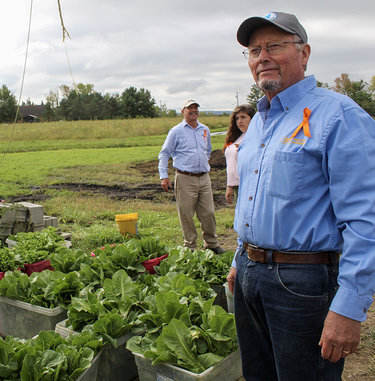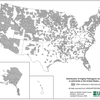Ag commissioner says bird flu can be prevented in NY cattle with right approach
ALBANY COUNTY — Farmers hoping to show their poultry and livestock at agricultural shows this year face testing requirements designed to prevent the spread of bird flu, which despite the name has been posing a threat to other species in recent months — including, in rare cases, people.
New York State Agriculture and Markets Commissioner Richard Ball told The Enterprise this week that the decision to implement animal testing was a “no-brainer” as part of the state’s ongoing efforts to keep bird flu from infecting local cattle, which so far has been effective.
Bird flu has been a major agricultural threat for years because of how deadly it is for poultry, and how quickly it spreads within and between flocks. In March of this year, however, infections started cropping up in cattle.
Although less deadly for cows than chickens, it does nevertheless have an impact on their productivity, and therefore farmers’ profits. But what has been especially concerning for scientists is that the pattern of infection in cows suggests that the virus is moving from cow to cow, rather than coming exclusively from birds. This raises questions about the capabilities of the virus, and how a potential infection-rate increase will impact both the agriculture industry and human health.
According to the United States Department of Agriculture, 13 states have had cattle herds affected, mostly in the midwest, but including states as near to New York as Ohio and Michigan. Within these 13 states, a total 179 herds have tested positive, with Michigan, Colorado, and Idaho making up about 60 percent of the total.
“It has not moved outside those 13 states for some time, although there’s some increase within the states,” Ball said.
There have been 14 cases of human infection from bird flu so far, according to the Centers for Disease Control and Prevention, 10 of which have been traced back to birds, and four of which came from cattle, indicating that the virus does have the ability to infect people, albeit with some apparent difficulty.
For now, the greatest threat seems to be on the milk supply.
“There’s two things here that concern us a great deal,” Ball said.
The first is that, when cattle catch this respiratory virus, “they go off feed, and their milk production drops off considerably, so you’re going to have an economic effect,” he said, explaining that it generally is about 10 percent of a herd that’s infected.
The second concern is cattle becoming a nexus for the disease, and passing it on to other kinds of agricultural species.
“For poultry,” Ball said, “it is fatal. There’s no ifs, ands, or buts about it.”
It’s so bad, in fact, that Ball said the only way to manage the spread among birds is to exterminate infected flocks.
According to Yale Medicine, there is also concern about the disease spreading to pigs, since it’s already known that pigs are susceptible to both human and animal flu viruses, but, like the threat posed to people, epidemiologists view that as more long-term, taking years or decades to fully develop.
Biosecurity
This context sets the stage for the state’s current measures, which focus primarily on animal transmission.
“We put an emergency order in place to … restrict the movement of animals coming from any impacted farm or any impacted state into New York State, to try to limit our exposure and our risk,” said Ball, explaining that the United States Department of Agriculture then followed suit by placing a more general restriction on all lactating dairy animals moving between states, regardless of their proximity to outbreaks.
The testing that’s part of those restrictions is now being applied to fairs in the state, where, naturally, there’s a higher risk for outbreak because of the confluence and density of all manner of animals.
“We need to have a test seven days prior to coming to the fair, and it has to be done by an approved lab,” Ball said.
The cost of the testing, he said, is picked up by USDA, so it’s of minimal burden to farmers, who have thus far been cooperative with the requirements.
“No one would want to expose their animal to this disease unwittingly, so I think it’s a no-brainer,” Ball explained. “It’s not a tough obstacle.”
Ultimately, he said, the state seems to be in a good position to ward off the threat of the virus, and he believes that it can be avoided entirely, at least as far as cattle are concerned.
“I have to believe, I want to believe, and I do believe that we can keep it out of our state by practicing good biosecurity on the farms and watching very closely what’s happening,” he said, explaining that Ag and Markets is in daily conversation with all sorts of agencies and organizations that have a stake in the issue, including the USDA, the Food and Drug Administration, and the National Association of Animal Health.
“We’re staying in close contact with all the right people,” Ball said. “We have a great milk-control division at the department, and we’ve been helping the FDA with testing, making sure the milk supply is safe. We’ve got one of the best state vets in the country, and we’ve got a good team of vets out there in our countryside and, of course, our veterinary network across the state.
“It’s going very well,” he said.
Ball said that the issue is not necessarily a new one for farmers, who already understand the principles of biosecurity and recognize when an animal needs to be quarantined, whether it’s because of bird flu or any number of other diseases.
So, despite the pall that this might have cast over fairs this year, Ball said that his travels around the state have shown life going on as normal, with kids and families having fun looking at “pretty nice-looking livestock.”
“I think we’re in a pretty good place,” he said. “Frankly, as good a place as we can be, because it is a concern, but we’re paying very close attention to it.”


